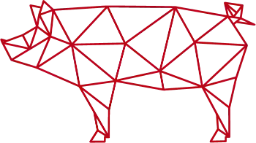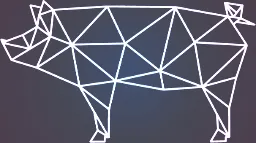- WHAT'S A DULA -
In the past, in Spain, a Dula referred to a communal pasture where the village animals grazed freely under the watch of a shepherd. Today, these lands are better known as Dehesa, a unique ecosystem that spans nearly 4 million hectares between Spain and Portugal. A true gem of the Iberian landscape, the Dehesa is a scenery shaped by both man and nature, where livestock farming and biodiversity coexist in perfect harmony.
In a Dula, the majestic holm oaks and cork oaks produce the famous Bellota (acorn), an essential food for Iberian pigs 🐖. These vast pastures provide an ideal setting for raising these animals, ensuring exceptional jamón ibérico.
Some Dulas have become legendary. Have you heard of Jabugo, Salamanca, or Huelva? These are regions where Iberian pigs are born and raised, producing the most sought-after hams.
At LA DULA, we select our products exclusively in Spain, from the best Dulas, led by passionate artisans. These experts uphold ancestral know-how and are recognized by the most demanding professionals in the industry.
(1) A WIDE VARIETY OF PIGS, UNMATCHED QUALITY
Choosing a perfectly aged jamón ibérico is an art. That’s why we collaborate with exceptional brands, rigorously selected for their quality, consistency, and authenticity. Each producer adheres to official Spanish standards and holds labels that guarantee the excellence of their hams.
We import our hams directly to Switzerland, ensuring total traceability and absolute control over each product.
- For our 100% Iberian Bellota hams (black label), we trust Juan Pedro Domecq, a key reference in Huelva.
- For our Cebo, Cebo de Campo, and Bellota Iberian hams, as well as our Iberian charcuterie, we work with Jovira in Extremadura.
- For our 100% Duroc ham, with an intense and marbled flavor, we have chosen Batallé, whose breeding and aging are done in the Sierra Nevada.
LA DULA is the guarantee of savoring an authentic jamón ibérico, selected with passion and rigor.
(2) THE DIFFERENT BREEDS OF HAM: ONE NAME, SEVERAL QUALITIES
We have all heard of Pata Negra, the famous 100% Iberian breed of pig. But why are there so many variations in quality?
In reality, the breeding of Iberian pigs is not always limited to pure breeds. Some pigs are crossed with the Duroc breed, which influences their taste, texture, and breeding methods. Furthermore, not all of them spend their lives free in a Dehesa: depending on their classification, some only partially benefit from this natural environment.
🔎 The diagram below illustrates the three types of crossings allowed in Spanish breeding and their impact on the quality of jamón ibérico.



🐖 IBERIAN PIGS: A TREASURE OF THE PENINSULA
Traditionally, Iberian pigs are raised in Dehesa (with the exception of Cebo), a unique ecosystem shared between Spain and Portugal. This iconic breed, native to the Iberian Peninsula, is distinguished by its black legs, from which the famous term "Pata Negra" originates.
But did you know that "Pata Negra" literally means "black legs"? However, today, this designation is exclusively reserved for 100% Iberian Bellota pigs, those that carry the black label, a guarantee of excellence and purity.
🐖 DUROC PIGS: AN ALLY OF THE IBERIAN
Less known to the general public but widely spread around the world, the Duroc pig is another variety of black pig. In Spain, it is frequently crossed with the Iberian pig, particularly for its meat texture and its ability to marbled fat over time.
Although 100% Duroc ham is a product of excellent quality, its aging provides a milder and less nuanced flavor compared to that of Iberian pigs. However, it remains a popular alternative for its melt-in-the-mouth texture and richness of flavors.
🐖 THE OTHER VARIETIES: A DIVERSE RANGE
Spain also produces a wide range of quality hams, made from different breeds of pigs. These hams, better known as Serrano, often carry labels such as "Reserva" and "Gran Reserva," without specifying the type of pig used.
Although they offer beautiful alternatives, they remain incomparable to the prestigious Iberian hams, whose breeding and aging follow much stricter criteria that guarantee a unique taste and texture.
(3) THE FEEDING OF IBERIAN PIGS: A KEY FACTOR IN QUALITY
The diet of Iberian pigs plays a crucial role in the quality of jamón. In Spain, it is strictly regulated and classified into three main categories:
De Cebo 🏠 – Farm-raised with a traditional diet based on grains and cereals.
De Cebo de Campo 🌿 – Mixed farming: at least 60 days in Dehesa, with a diet combining grains, natural pastures, and wild resources.
De Bellota 🌳 – 100% free-range farming, in the Dehesas, with a diet based on bellotas (wild acorns) for at least 60 days before aging.
Each breeding method influences the taste, texture, and quality of the jamón, making Bellota the most prestigious and sought after.



BELLOTA, THE (NOT SO) SECRET FOOD OF IBERIAN PIGS
The living conditions in a Dehesa are harsh, but that is precisely what creates an ideal environment for raising Iberian pigs. Its main food? The acorn, or "Bellota" in Spanish, a key ingredient that gives Iberian ham its unique flavor and melt-in-your-mouth texture.
The true 100% Iberian pig feeds exclusively on acorns and natural pastures throughout its life. It spends its days roaming the Dehesa in search of these fruits rich in natural fatty acids, which provide it with the perfect fat infiltration and the subtle nutty aromas found in its ham.
However, not all varieties of Iberian pigs follow the same diet. Some benefit from a mixed diet, combining acorns and grains, while others, resulting from crossbreeding, never taste acorns and are fed exclusively on grains.
These differences in diet directly influence the flavor, texture, and quality of the ham. Make sure to do your research before ordering to choose the one that meets your taste expectations!
(4) LABELING OF IBÉRICOS: UNDERSTANDING THE DIFFERENCES
In Spain, jamón ibérico is classified according to an official color code, ensuring its origin, diet, and breeding method. Here’s how to navigate it:
⚪ White Label – Iberian Cebo
Iberian pig raised on a farm, fed grains and legumes, with no access to pastures. ➡ Minimum aging: Jamón 18 months | Paleta 12 months
🟢 Green Label – Iberian Field Cebo
Raised outdoors for at least 60 days, with a mixed diet consisting of grains, herbs, and natural resources. ➡ Minimum aging: Ham 18 months | Shoulder 12 months
🔴 Red Label – 50% or 75% Acorn-fed Ibérico
Raised in Dehesa, fed on acorns and natural pastures during the montanera. ➡ Minimum aging: Ham 24 months | Shoulder 12 months
⚫ Black Label – 100% Acorn-Fed Ibérico (Pata Negra)
The highest quality: 100% Iberian pork, raised free-range and exclusively fed on acorns. ➡ Minimum aging: Jamón 24 months | Paleta 12 months
👉 Understanding these labels means choosing a jamón that matches your expectations and savoring the authenticity of the ibéricos!




- THE JAMÓN'S LANGUAGE -
La Dula
An Iberian pasture in Spain where 100% Iberian pigs are raised.
Bellota
Wild acorn used to feed Iberian pigs raised freely in a Dehesa.
Cebo
The act of fattening the pig with a specific grain-based diet.
Porc Ibérique
An exclusive purebred pig, native to the Iberian Peninsula.
Porc Duroc
A pig breed similar to the Ibérico but less rare, also recognizable by its black legs.
Pata Negra
A 100% Iberian breed pig raised in a Dehesa and fed with wild acorns under official supervision. This high-quality ham receives the best label: the BLACK label.
Jamón 100% Ibérico de Bellota
A purebred Iberian pork ham, recognizable by its black legs. This high-quality ham receives the best label: the BLACK label.
Jamón Ibérico de Bellota
A ham from a crossbreed of Ibérico (50% to 75%) and Duroc breeds. This high-quality ham receives the RED label.
Jamón Ibérico de Cebo de Campo
A ham from a crossbreed of Ibérico (50% to 75%) and Duroc, fed with grains and quality pasture. This high-quality ham receives the GREEN label.
Jamón Ibérico de Cebo
A ham from a crossbreed of Ibérico (50% to 75%) and Duroc, fed with grains. This high-quality ham receives the WHITE label.
Jamón 100% Duroc
A ham from a purebred pig known as Duroc.
Huelva / Extremadura / Salamanca / Los Pedroches
Regions of Spain where unique Dehesas are found and where Iberian pigs are raised.
Jabugo
A small village in the Huelva region, known worldwide for its Jamón.